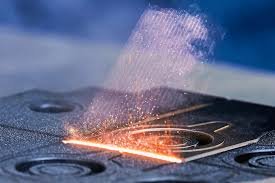Corrosion is a natural process that leads to the deterioration of metal. If left unchecked, rust can compromise the integrity and function of metal objects. For instance, a rusted pair of pliers won’t work as it should—the corrosion creates resistance and damages the surface over time.
While various methods exist to tackle this problem, laser rust removal stands out as a state-of-the-art solution. It’s a highly effective and efficient way to strip away unwanted layers, making it the preferred method in modern industries.
This article will delve into the details of this revolutionary process, explaining how it works, its numerous benefits, and its practical applications.
How Laser Cleaning Works
The process of laser cleaning is a highly precise technique known as laser ablation. This method uses powerful, focused laser beams to remove material from a solid surface. Every material has a unique ablation threshold—the point at which it will vaporize when exposed to sufficient energy.
A laser cleaning machine generates intense laser beams that instantly raise the temperature of the target surface. When these beams hit a rusty surface, the rust’s temperature rapidly exceeds its ablation threshold. This intense heat causes the bonds between the rust and the metal to break, effectively removing the rust without harming the metal underneath.
This non-contact process can remove not only rust (oxides, sulfides, and hydroxides) but also other contaminants like paint and oil. Since each material has a different ablation threshold, the laser’s energy can be finely tuned to selectively remove only the unwanted layers, leaving the base material untouched.
Key Applications of Laser Rust Removal
Laser rust removal is a versatile tool with a wide range of applications:
- Pre-Welding Treatments: For a high-quality weld, the metal must be perfectly clean. Contaminants like oxides and grease can cause porosity and weaken the joint. Laser cleaning effectively prepares the surface, ensuring a strong and clean weld.
- Post-Welding Treatments: After welding, a layer of residue often forms around the joints. This must be cleaned before applying paint or other coatings to ensure a smooth finish and proper adhesion.
- Oxide Removal: Metals often develop an oxide layer over time. Before any manufacturing or finishing process, it’s essential to remove this layer. Laser cleaning provides a quick and efficient solution.
- Parts Cleaning: When machine parts are affected by corrosion, they don’t always need to be replaced. A laser can restore a rusted component to a like-new condition, saving time and money. This makes it invaluable for maintaining equipment in industries from automotive to military.
The Benefits of Laser Cleaning
Compared to traditional methods, laser cleaning offers significant advantages:
- Speed and Efficiency: Laser rust removal is an incredibly fast process, often taking just a few seconds or minutes depending on the object’s size. It is far quicker than sanding, grinding, or chemical treatments, boosting productivity.
- Versatile Contaminant Removal: A single laser machine can remove multiple types of contaminants, including rust, paint, and oil, making it an all-in-one solution for metal cleaning.
- Safety and Environmental Friendliness: Traditional methods like grinding release hazardous airborne particles, while chemical treatments involve dangerous acids that require careful handling and disposal. Laser cleaning is a much safer, non-toxic process. It can be used indoors, and the exhausted air can be purified before release, making it the most environmentally friendly option available.
- No Damage to the Base Metal: Laser cleaning is a non-contact process that only removes the unwanted layer. When set to the correct power and speed, the laser will not damage the underlying metal, leaving the surface in a pristine, like-new condition.
Types of Lasers for Rust Removal
Laser machines come in various types tailored for different purposes. For rust removal, the most common are fiber laser machines and infrared laser machines.
Fiber laser machines are incredibly powerful and ideal for large-scale, industrial rust removal. They are also suitable for other tasks like paint removal, degreasing, and surface texturing. A fiber laser can be doped to achieve a specific wavelength, and pulsed fiber lasers are particularly effective as they deliver very high peak power in short bursts. While they can be expensive, they are the top choice for heavy-duty applications.
Infrared laser machines, with their wavelength around 1064nm, are also suitable for metal cleaning, as this wavelength is easily absorbed. While less powerful than a fiber laser, they are more affordable and often available in portable, handheld designs. They are an excellent option for DIY enthusiasts and small-scale tasks.
Conclusion
Laser rust removal is the safest, fastest, and most cost-effective method for cleaning metal. Whether you choose a high-powered fiber laser for industrial use or a smaller infrared laser for personal projects, the results of laser cleaning are always impressive. The ability to restore a rusted object to its original state without hassle ensures this technology will remain a vital tool for years to come.




